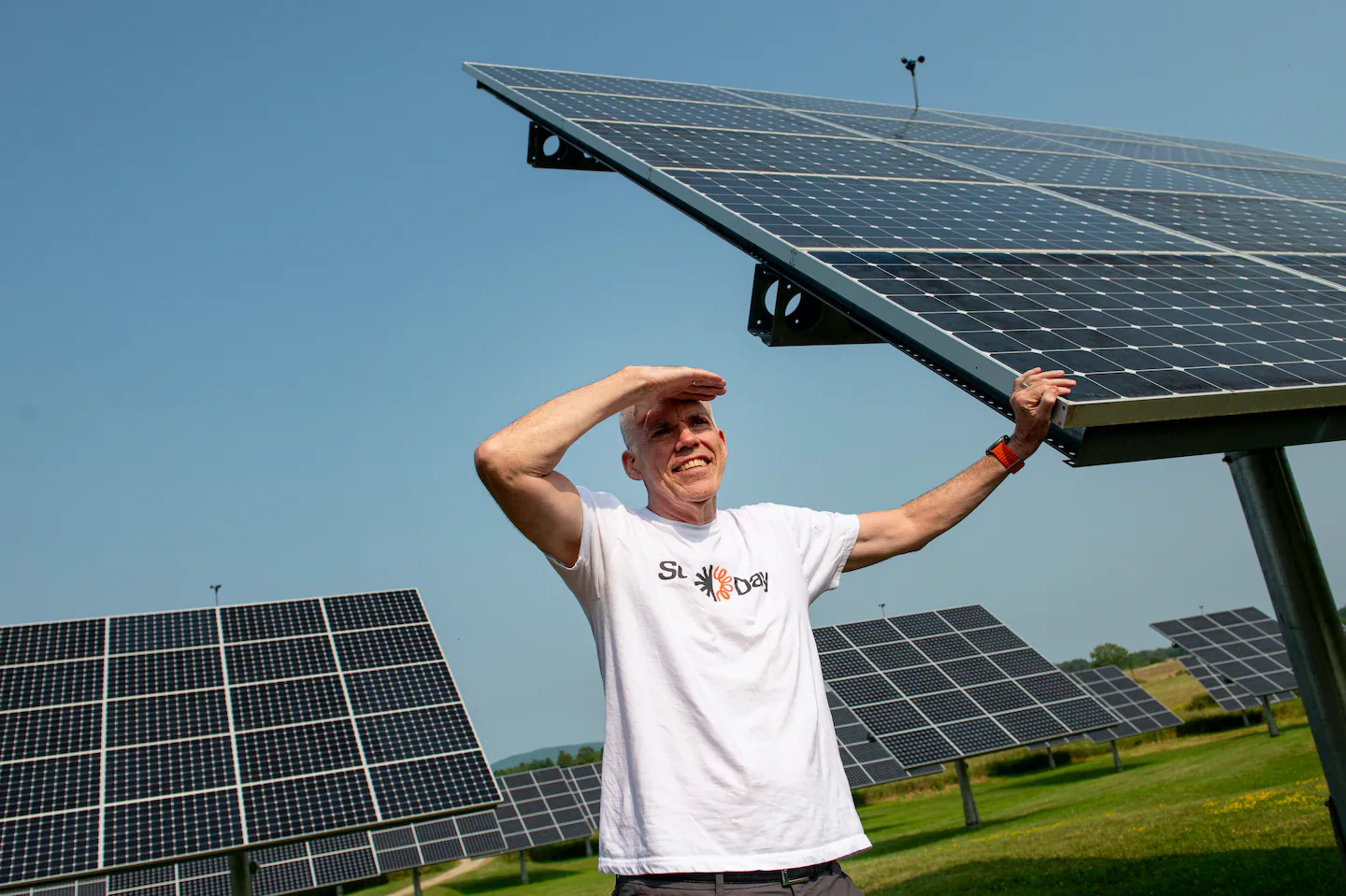
Centuries of change, driven by energy. On a sunny July day, that’s what Bill McKibben, the writer and perhaps the most well-known environmentalist apart from Al Gore, wants to talk about. Because, the way he sees it, we’re poised to see another big change. And this one — the fastest yet — might just save us.
“Energy needs to be understood in a fundamentally different way — as ubiquitous and diffuse, instead of scarce and concentrated, which is the sort of mantra of the fossil fuel age,” McKibben says, as we sit looking at Otter Creek, partway through an unofficial energy tour of Middlebury, Vermont.
That ubiquitous and diffuse source, of course, is solar energy — an energy source that is being steadily fought against in the United States, where President Trump is clawing back federal incentives and throwing up hurdle after hurdle to the industry. Even so, solar power is continuing to grow here; and elsewhere, in the rest of the world, it is being embraced at a blistering speed.
That’s the theme of McKibben’s latest book, Here Comes the Sun: A Last Chance for the Climate and a Fresh Chance for Civilization, which came out last month.
At a time when the markers of a warming planet couldn’t be clearer, when the political will to address the climate crisis appears to be diminishing, McKibben makes the deeply hopeful case that if you widen your perspective, you’ll see the next transition isn’t just beginning — it’s well underway.
By the middle of 2023, McKibben writes, a gigawatt’s worth of solar — roughly the output of a typical coal-fired power plant or nuclear reactor — was being installed globally each day. By last fall, it was happening every 18 hours.
In Pakistan, in homes, shops, and factories, people built out the equivalent of a third of the nation’s electric grid within a year, using cheap solar panels from China.
China, meanwhile, set a goal back in 2020 of producing 1,200 gigawatts of clean energy by 2030 — but hit that target in mid-2024.
“In a world where almost everything seems to be going wrong, this is the one big thing suddenly going right,” McKibben writes.
In many ways, this is the moment he has been waiting for. For 30 years, he and the legions of activists he has inspired through the climate activism groups 350.org and Third Act have been working faithfully to slow the expansion of fossil fuels, he tells me.
“We did divestment, raised the cost of capital, made it harder for them to build, but all that time in the hope that we were doing our best to create a vacuum that something else would start to fill,” he says. “And now that something else is starting to fill it.”
McKibben and I had first met up the evening before, at Dartmouth College, in Hanover, New Hampshire. He was there to spread the gospel of solar while helping raise funds for Clean Energy NH, a nonprofit that advocates for clean energy and rabble-rouses at New Hampshire’s right-leaning State House.
The view in McKibben’s book may be a largely optimistic one, but in the packed foyer of Dartmouth’s Irving Institute for Energy and Society, the outlook of the future felt decidedly less so.
“As most of you know, the flood is coming at us,” Bill Bender, president of Solaflect Energy, which makes solar-powered EV chargers, told the group before McKibben spoke. “There really has been a major change in the last six months, and it’s kind of shocking to me how effectively climate change has gotten pushed to the side.”
Sam Evans-Brown, executive director of Clean Energy NH, took the microphone next. He explained the work his group has done to help cities and towns transition to clean energy. But, he noted, federal grants for clean energy initiatives that financed much of the group’s work no longer exist.
“We do believe that if Clean Energy NH is going to endure at this size, we’re going to have to pivot and rely on local support,” he said.
It is an impossibly hard time for those working on climate change in the United States, McKibben acknowledges — a “deeply, deeply shameful” moment, in which the country is not only walking away from its commitment to slow the pace of global warming, but also ceding its leadership on a global stage.
Yet, as he does in the book, he allowed the numbers to tell the story. “China, in May, was putting up 100 solar panels a second,” he tells the attendees. “Three gigawatts every day in the month of May — the equivalent of three coal-fired power plants.”
Then there’s California, where a boom in solar and batteries for storage meant that for a portion of most days in 2024, the state’s energy needs were being met with renewable energy.
“People still think about renewable energy as the Whole Foods of energy — nice, but pricey,” he says. “We have to realize it’s the Costco of energy. It’s cheap, it’s available in bulk, and it’s ready to go.”
He’s trying to shift that perception, both with the book and with a day of action — called Sun Day — that’s planned for September 21. The hope is that through thousands of events held across the country, the Sun Day organizers, including McKibben, can help show that the technology and solutions for the clean energy revolution are all available. What’s lacking is political will.
After the talk, McKibben and I made our plan to meet up the following morning, and then hit the road in our respective cars for the mountainous drive to Vermont.
We spend the next morning on a walking tour of Middlebury’s energy past and future — starting with the dam at Otter Creek, and continuing through town to Middlebury College’s first solar installation, a small cluster of panels that rise up on the side of a field off Route 125.
Since their installation more than a decade ago, the college has added a second, larger solar field — one that meets 40 percent of the school’s energy needs.
McKibben has been a professor at Middlebury for more than 20 years — one of several hats he wears in addition to writing for The New Yorker, authoring books, and working in activism. Though he began his career as a journalist, during the process of writing his first book about the climate crisis, called The End of Nature, he realized that the traditional role of observer-journalist wasn’t for him. The stakes were far too high.
We end our day a few towns over in Ripton for a quick stop at McKibben’s home. His plot is nestled on a dirt road off another dirt road, abutting a national forest — wilderness that extends for miles and miles.
As we walk into the backyard, his dog Birke comes to greet him with a nuzzle. McKibben points to his roof, which is covered in solar panels — enough to meet their needs in summer, he tells me — and we head inside where he introduces me to his wife, writer Sue Halpern.
It’s not lost on McKibben that he’s publishing a largely optimistic book at a time that is deeply dark and scary for those who care about the climate. He feels that disconnect.
As one of the people who has likely written the most words about climate change, McKibben jokes that he is perhaps the least successful writer on the planet, given the current state of the climate.
But even when he’s despairing, he says, he can still find reason to hope — enough uncertainty within the science to indicate that if we act fast enough and with enough seriousness, we’re not past the point of no return.
Despite the hopeful tone of the book, the stakes are always on his mind.
“I have little doubt we will run the world on sun and wind 40 years from now,” he writes. “But if it takes us anything like 40 years to get there then it will be a broken planet.”
We wrap up, and our conversation shifts to the route I’ll take for my long drive home to Maine. On this, McKibben and Halpern share the same strong opinion: Do not, under any circumstances, follow the directions my phone will recommend — the ones that will guide me on the fastest route.
They, instead, walk me through a series of turns that will lead me on a longer path, but one that drives across the peaks of the White Mountains, through the best of what Northern New England has to offer.
I bid them goodbye and take their advice, adding about an hour to my drive. My little Prius climbs winding pass after winding pass, a seemingly endless expanse of forest on either side. As the sun glints through my windshield and spreads across valleys below, it’s easy to see why McKibben ends his book on note of faith.
“The sun, while enormous, is not too enormous, not for us,” he writes. “It provides us each year with about 720 times more energy than humans currently use. That’s a conceivable number — it means we can harvest a small fraction of it and have far more than we need. It means that we can count on the sun.”



